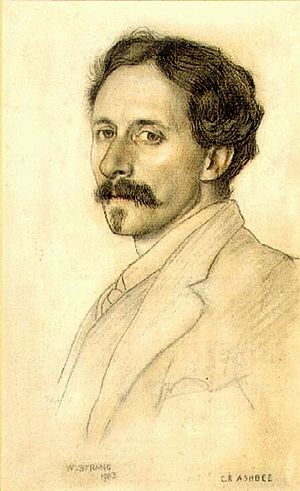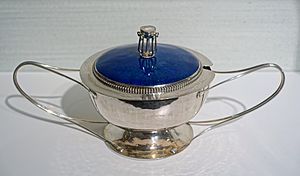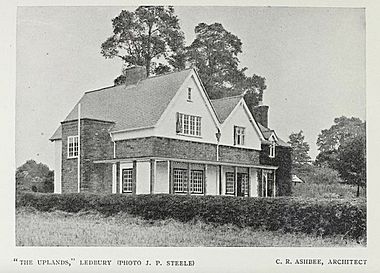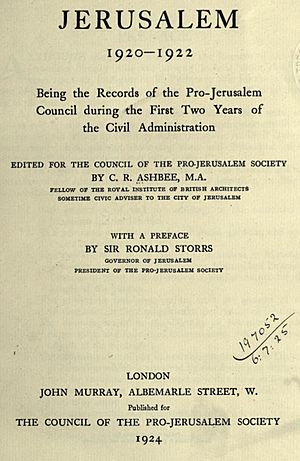Charles Robert Ashbee facts for kids
Quick facts for kids
Charles Robert Ashbee
|
|
|---|---|

C. R. Ashbee by William Strang, 1903
|
|
| Born | 17 May 1863 Isleworth, United Kingdom
|
| Died | 23 May 1942 (aged 79) Sevenoaks, United Kingdom
|
| Resting place | St Peter and St Paul Churchyard, Seal, Kent, United Kingdom |
| Education | Wellington College, King's College, Cambridge |
| Spouse(s) | Janet Elizabeth Forbes (1877–1961) |
| Children | 4 |
Charles Robert Ashbee (born May 17, 1863 – died May 23, 1942) was an English architect and designer. He was a key figure in the Arts and Crafts movement. This movement focused on making beautiful things by hand. It was inspired by the ideas of John Ruskin and William Morris.
Ashbee was known for many things. He was a designer, architect, and someone who wanted to make society better. He worked with metal, designed textiles, furniture, and jewelry. His style mixed the Modern Style (British Art Nouveau style) with Arts and Crafts ideas. He became a member of the Art Workers' Guild in 1892. Later, he was chosen as its Master in 1929.
Contents
Early Life and Education
Ashbee was born in 1863 in Isleworth. This area is now a part of London. He was the first child and only son of Henry Spencer Ashbee, a businessman. His mother was Elizabeth Jenny Lavi.
Charles Robert Ashbee went to Wellington College. He then studied History at King's College, Cambridge from 1883 to 1886. He also learned about architecture from George Frederick Bodley.
Guild and School of Handicraft
In 1888, Ashbee started his Guild and School of Handicraft in London. He wanted to help people in poor areas. The Guild first had workshops in the East End of London. It also had a shop in the fancy West End. This made it easier for people to buy the Guild's products.
The School part of the Guild closed in 1895. Ashbee felt that other schools with government help made it hard to continue. The next year, a new school, the Central School of Art and Design, opened.
One of Ashbee's students was Frank Baines. Frank later became very important in keeping Arts and Crafts ideas alive in architecture.
In 1902, the Guild moved to Chipping Campden. This is a village in the Gloucestershire Cotswolds. Here, local people supported their work. However, by 1905, there were too many similar craft businesses. The Guild closed in 1907.
The Guild of Handicraft was good at metalworking. They made jewelry, enamels, and items from copper and iron. They also made furniture. The School taught these crafts. The Guild wanted to make high-quality handmade items. They also wanted to make sure craftsmen were respected. They aimed to be different from regular factories. In factories, workers often had little say or interest beyond their pay.
Ashbee himself often designed items made of silver and other metals. These included belt buckles, jewelry, cutlery, and tableware.
Architecture and Design in Europe
As an architect, Ashbee designed entire houses. This included the furniture and decorations inside. He also designed things like fireplaces. In the 1890s, he updated The Wodehouse in Staffordshire. He added a billiard room and a chapel.
In 1907, he designed the Villa San Giorgio in Taormina, Sicily. This house was meant to feel like a small piece of England in Italy. Today, it is a hotel called Hotel Ashbee.
He also designed buildings in Budapest and London. This included several art studios in Cheyne Walk, Chelsea. His own family home was also at 37 Cheyne Walk.
Survey of London
Ashbee also started the Survey of London. This project aimed to record historic buildings in London. He was worried that many old buildings were being torn down. The Survey helped to keep a record of these important places.
Book Author and Publisher
Ashbee was also involved in making books and writing. He started the Essex House Press in 1898. This happened after William Morris's Kelmscott Press closed. Ashbee hired many of the skilled printers from Morris's press. Between 1898 and 1910, the Essex House Press published over 70 books. Ashbee even designed two special typefaces for his press.
He wrote books about design, such as "A Book of Cottages and Little Houses" (1906) and "Modern English Silverwork" (1909).
After working in Jerusalem, Ashbee wrote a report in 1924. It was called Jerusalem, 1920-1922. It described the work of the Pro-Jerusalem Society.
Ashbee also wrote two utopian novels. These were inspired by William Morris. They were From Whitechapel to Camelot (1892) and The Building of Thelema (1910).
Work in Jerusalem (1918–1923)
In 1918, Ashbee was chosen to be a civic adviser in Jerusalem. This was during the time when Britain was in charge of Palestine. His job was to look after building projects and protect old buildings and monuments. He was the chairman of the Pro-Jerusalem Society. His family moved to Jerusalem and lived there until 1923.
Ashbee worked to protect the traditional style of the city. He oversaw efforts to save and repair buildings. He also helped to bring back local craft industries. This included repairing the famous Dome of the Rock.
Personal Life
Ashbee was a complex person. He was described as an idealist who put his ideas into practice.
In 1898, Ashbee married Janet Elizabeth Forbes. They had four children: Mary, Helen, Prudence, and Felicity.
Death
Charles Robert Ashbee died in 1942 in Sevenoaks. He was buried at St Peter and St Paul's Church in Seal, Kent. He had designed the internal screen for the church tower.
Legacy
Ashbee's writings and personal journals are kept at King's College, Cambridge. His unpublished personal memories are at the London Library.
The East End Preservation Society has held a special lecture in his memory since 2015. These lectures discuss topics related to architecture and urban planning.
See also
 In Spanish: Charles Robert Ashbee para niños
In Spanish: Charles Robert Ashbee para niños
- Birmingham Guild and School of Handicrafts, which was similar to Ashbee's Guild.
- Clifford Holliday, another town planner who worked in Palestine after Ashbee.
- Ernest Tatham Richmond, a British architect who worked on the Haram ash-Sharif.




